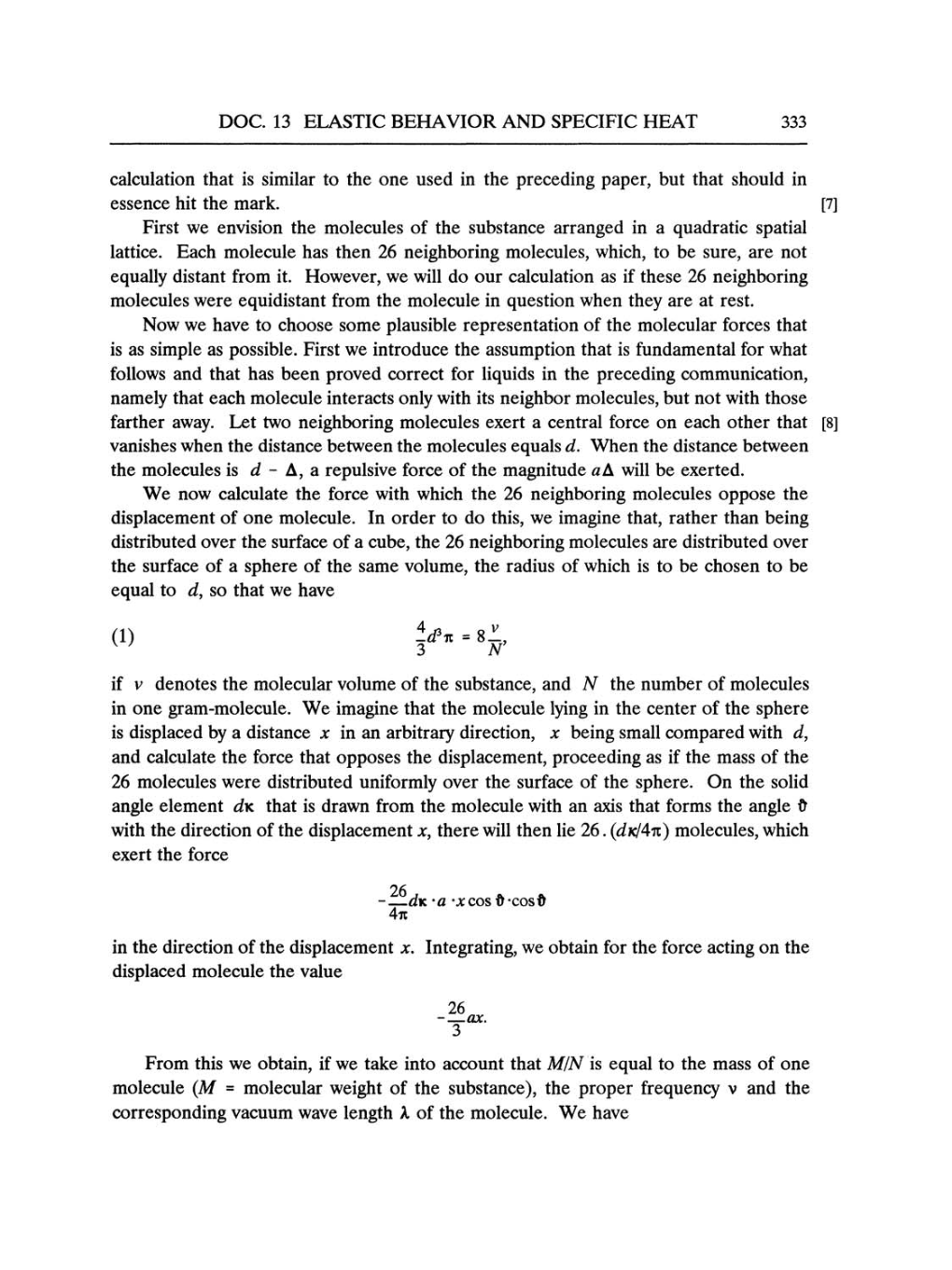DOC.
13
ELASTIC BEHAVIOR AND SPECIFIC HEAT
333
calculation
that
is
similar to
the
one
used
in
the
preceding paper,
but that
should in
essence
hit the mark.
[7]
First
we
envision
the
molecules
of the
substance
arranged
in
a
quadratic
spatial
lattice.
Each molecule
has
then
26
neighboring molecules, which,
to be
sure, are
not
equally
distant
from it.
However,
we
will
do
our
calculation
as
if
these
26
neighboring
molecules
were
equidistant
from
the molecule
in
question
when
they are
at rest.
Now
we
have to choose
some
plausible representation
of the molecular
forces
that
is
as
simple
as
possible.
First
we
introduce
the
assumption
that
is
fundamental for
what
follows
and that
has
been
proved
correct
for
liquids
in
the
preceding
communication,
namely
that each
molecule
interacts
only
with its
neighbor
molecules,
but
not with
those
farther
away.
Let
two
neighboring
molecules
exert
a
central
force
on
each other that
[8]
vanishes when
the distance between the molecules
equals
d.
When the
distance
between
the molecules
is
d
-
A,
a
repulsive
force
of the
magnitude
aA will
be exerted.
We
now
calculate
the
force with which
the
26
neighboring
molecules
oppose
the
displacement
of
one
molecule.
In order
to
do
this,
we
imagine that,
rather than
being
distributed
over
the
surface
of
a
cube,
the
26
neighboring
molecules
are
distributed
over
the
surface
of
a
sphere
of the
same volume,
the radius of
which
is
to
be chosen
to be
equal
to
d, so
that
we
have
(1)
IcPn
=
8l,N
w
3
if
v
denotes the molecular
volume
of the
substance,
and
N the number of
molecules
in
one gram-molecule.
We
imagine
that the molecule
lying
in
the
center
of the
sphere
is
displaced by a
distance
x
in
an
arbitrary
direction,
x
being
small
compared
with
d,
and calculate
the
force
that
opposes
the
displacement, proceeding as
if
the
mass
of the
26
molecules
were
distributed
uniformly over
the
surface
of the
sphere.
On the
solid
angle
element
dK
that
is
drawn
from the molecule
with
an
axis
that
forms
the
angle
ö
with
the direction of
the
displacement
x,
there
will
then
lie 26.
(dk/4z)
molecules,
which
exert
the
force
--dn-a-x
cos
ü
-cos
0
4it
in
the direction of
the
displacement
x.
Integrating, we
obtain for the
force
acting
on
the
displaced
molecule
the
value
26
--ax.
3
From
this
we
obtain,
if
we
take into
account
that
M/N
is
equal
to
the
mass
of
one
molecule
(M
=
molecular
weight
of the
substance),
the
proper frequency
v
and the
corresponding
vacuum wave
length
A
of the
molecule.
We
have
